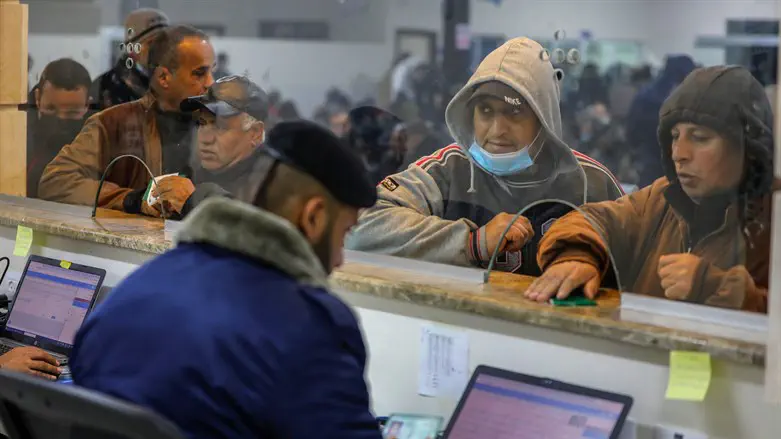
The Gaza laborers' role in the October 7 massacre
Many Israelis worried about the security risks, citing occasional laborers involved in terrorist acts. It was much worse. Op-ed.

Dr. Medoff is founding director of The David S. Wyman Institute for Holocaust Studies and author of more than 20 books about Jewish history and the Holocaust. His latest is America and the Holocaust: A Documentary History, published by the Jewish Publication Society & University of Nebraska Press.
The status of day laborers from Gaza has always been a bone of contention between Israel and its critics. The State Department has repeatedly pressed Israel to admit more of them. Many Israelis worried about the potential security risks, citing the occasional laborer involved in a terrorist act.
Now it turns out that the security risk was much greater than anybody imagined.
The Washington Post reported November 12 that the reason the Hamas terrorists were so well versed in the access points, layout, and other aspects of the Israeli towns they invaded is because they had “compiled information from Gazan day laborers, who were allowed to enter Israel every day to work.” The Post cited as its sources for this fact “intelligence officials from multiple countries.”
“Many of the laborers worked in the communities that were ravaged by Hamas, where entire families were shot, burned alive, and mutilated in their homes,” the Times of Israel noted. It should be mentioned that Israelis were especially kind to these workers, giving them gifts and trying to be friendly.
Until October 7, the main security risk from the day workers appeared to stem from the relatively small number of individual laborers who used their access to commit acts of terrorism.
One such episode in 1994 particularly shook the Israeli public. The victim was a Holocaust survivor named Isaac Rotenberg, whose life in many ways had symbolized the rise and success of the State of Israel.
Deported with his family to the Sobibor death camp as a teenager, Rotenberg managed to escape during the October 1943 uprising at the camp. After the war, he made his way to British Mandatory Palestine. Despite all he had suffered, despite the loss of most of his family and his own brushes with death, Rotenberg found himself compelled to take up arms again, this time as a soldier in Israel's War of Independence.
When the war ended, he and his countrymen set about building new lives. He married, raised two children, and helped found the Tel Aviv suburb of Holon. Rotenberg was a plasterer by profession, but when he reached retirement age in 1993, he was too devoted to his lifestyle of old-fashioned hard work to turn his attention to bridge or shuffleboard. That’s why, on the morning of March 29, 1994, the 67 year-old Rotenberg was fixing the tiles in a floor in a building in Petah Tikvah.
Two of the other workers, Abu-Moussa Atiya and Shabbi Hazam, came each day from Gaza. On March 29, when Rotenberg's back was turned, Atiya and Hazam butchered him with axes. The State Department later pressured Israel to free a number of imprisoned terrorists as a “confidence-building gesture” to the Palestinian Authority, and Atiya walked free.
Despite such episodes, some past and present U.S. officials have called on Israel to significantly increase the number of day laborers it admits from Gaza. In 2018, Hady Amr—today the State Department’s Special Representative for Palestinian Affairs—coauthored a Brookings Institution report urging Israel to admit 50,000 to 75,000 Gazan laborers daily.
In a 2015 Washington Post op-ed, former U.S. official David Makovsky and former Palestinian Authority official Ghaith Al-Omari suggested that Israel should be pressed to “take steps such as allowing 100,000 Gazan workers into Israel, matching the number of West Bankers already working there."
Israeli government officials whom I interviewed at the time were skeptical about making policy on the basis of arbitrary considerations such as numerical symmetry. They pointed out that in the aftermath of Israel’s withdrawal from Gaza, they had fewer intelligence sources there and thus were less able to screen out potential security risks.
During the year preceding the October 7 pogrom, the number of Gazans permitted to enter Israel usually fluctuated between 10,000 and 15,000. Now we know, from the Washington Post, that those workers were the source of much of Hamas’s information. One can only imagine the additional damage that would have been done - that is, massacring and burning - if 100,000 laborers had been entering Israeli towns every day.
A spokesman for Israeli victims of terrorism told me back in 2015, “It’s very easy for State Department officials or think tank pundits to sit in Washington and tell Israel how many Gazans it should admit, but they will not suffer the consequences when their proposals explode, which happens pretty often in this very dangerous part of the world. We Israelis will be the ones who end up paying the price."
Those words seem all the more prescient—and painful—in the wake of October 7 and its aftermath.